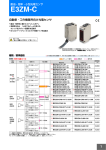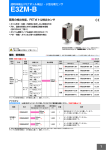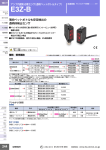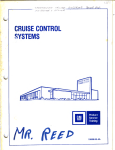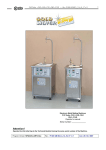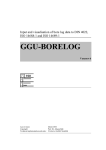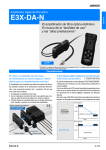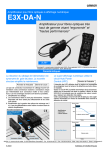Download BH FITNESS XS3 - Specifications
Transcript
Mark Sensor with Stainless Steel Housing Compact, Photoelectric Sensor with Built-in Amplifier and Teaching Function E3ZM-V Color Mark Detection in a World-standard Size (11 × 21 × 32 mm), with High-speed Response (50 µs) and Accuracy in Spite of Sensing Object Movement Another Advance for the E3ZM Series in the Food and Packaging Industries. World's Smallest✽ Color-mark Sensor with Built-in Amplifier ✽According to OMRON investigation. The E3ZM-V provides superior optical performance and yet is the same size as the E3Z. This compact, high-speed Mark Sensor remains accurate in spite of sensing object movement. Color Mark Sensors Now Join the E3ZM Series of Photoelectric Sensors for the Food Industry ■ Space-saving Design with an SUS316L Housing E3ZM Standard Size The compact design reduces volume by 90% compared with previous OMRON models. And the world-standard dimensions contribute to standardized installation specifications. Only 10% the volume! Previous OMRON model (E3M-V) E3ZM-V ■ Coaxial Optical System in a Compact Design Although the E3ZM-V is only 11 × 21 × 32 mm, it uses a coaxial optical system. Straight Sensing Object RGB light-receiving element Half mirror Even if the sensing object is inclined, reflected light is captured with the coaxial optical system to provide stable detection. Lens Sensing object (with regular reflection) White LED Inclined Sensing Object RGB light-receiving element Half mirror Lens White LED ■ IP69K Degree of Protection with an SUS316L Housing The housing is constructed of corrosion-resistant SUS316L, and the display cover is PES (polyethersulfone). Both materials are highly resistant to the effects of detergents and disinfectants. IP69K degree of protection also allows the E3ZM-V to withstand washing with high-temperature, high-pressure water. This makes the E3ZM-V well suited to use in sites requiring a high level of hygiene. Sensing object (with regular reflection) Same Durability as the E3ZM E3ZM-V Cutting-edge Technologies Give This Color Mark Sensor Its Compact Size and Superior Performance. ■ Improved Color-difference Discrimination, RGB Signal Processing Discriminates fine color differences which was difficult for previous OMRON models. RGB light-receiving element Teaching enables automatic selection of ideal colors. Plus, response is a fast 50 µs for both ON and OFF operation. Patent pending White LED ■ Easy Setting with 2-point and Automatic Teaching ● 2-point Teaching (Manual) Simply aim the beam spot at the mark portion and background portion, and press the teaching button. ● Automatic Teaching (Remote) Send a pulse to the remote control input and have the mark pass by seven times for automatic teaching. (Note: There is no answer-back output.) Color Mark Detection Compact Photoelectric Sensor E3ZM-V Industry's Smallest Color Mark Sensor • Excellent space savings. (Reduced by 90% compared with previous OMRON models.) • Improved color-difference discrimination with white LED and RGB signal processing. • Equipped with two types of teaching: 2-point teaching and automatic teaching. Ordering Information Sensor [Refer to Dimensions on page 13.] Sensing method Appearance White light Connection method Sensing distance Pre-wired (2 m) *1 Mark Sensor (Diffuse reflective) Connector (M8, 4 pins) 12±2 mm *2 Model NPN output PNP output E3ZM-V61 2M E3ZM-V81 2M E3ZM-V66 E3ZM-V86 *1. Models with a 5-m pre-wired cable are also available. When ordering, add the cable length to the end of the model number (e.g., E3ZM-V61 5M). *2. A deviation of ±2 mm (typical value) can be handled for combinations of white, yellow, and black. Refer to page 7 for the detection capability for other color combinations. Accessories Sensor I/O Connectors (Models for Connectors: A Connector is not provided with the Sensor. Be sure to order a Connector separately.) [Refer to Dimensions on XS3.] Size Cable Appearance Straight M8 (4 pins) Cable type 2m 5m Standard L-shaped 2m 5m Model XS3F-E421-402-A 4-wire XS3F-E421-405-A XS3F-E422-402-A XS3F-E422-405-A Note: The outer cover of the cable is made of PVC (polyvinyl chloride), the nut is SUS316L, and the degree of protection is IP67. When high-pressure washing will be used, select an I/O Connector that has IP69K degree of protection. 4 E3ZM-V Mounting Brackets A Mounting Bracket is not provided with the Sensor. Order a Mounting Bracket separately if required. [Refer to Dimensions on E39-L/F39-L/E39-S/E39-R.] Appearance Model (Material) E39-L153 (SUS304) Quantity Remarks 1 Appearance Model (Metal material) Quantity Remarks E39-L98 (SUS304) 1 Protective Cover Bracket * E39-L150 (SUS304) 1 set Mounting Brackets E39-L104 (SUS304) E39-L43 (SUS304) 1 1 Horizontal Mounting Bracket * E39-L142 (SUS304) 1 Horizontal Protective Cover Bracket * E39-L44 (SUS304) 1 Rear Mounting Bracket E39-L151 (SUS304) 1 set E39-L144 (SUS304) 1 (Sensor adjuster) Easily mounted to the aluminum frame rails of conveyors and easily adjusted. For vertical angle adjustment Compact Protective Cover Bracket * * Cannot be used for Standard Connector models. 5 E3ZM-V Ratings and Specifications Sensing method Diffuse reflective (mark detection) NPN output E3ZM-V61/-V66 Model Item PNP output E3ZM-V81/-V86 Sensing distance 12±2 mm *1 Sensing range Depends on the combination of colors. Refer to Engineering Data on page 7 for details. Spot diameter 2-mm dia. max. Light source (wavelength) White LED (450 to 700 nm) Power supply voltage 10 to 30 VDC, including 10% ripple (p-p) Power consumption 600 mW max. (current consumption for a 30-V power supply voltage: 20 mA max.) Control output Load power supply voltage: 30 VDC max., Load current: 100 mA max. (Residual voltage: 2 V max.) Open-collector output (NPN/PNP output depending on model) Remote control input NPN output ON: Short-circuit to 0 V, or 1.5 V max. (source current: 1 mA max.) NPN output OFF: Open or Vcc −1.5 V to Vcc (leakage current: 0.1 mA max.) PNP output ON: Vcc −1.5 V to Vcc (sink current: 1 mA max.) PNP output OFF: Open or 1.5 V max. (leakage current: 0.1 mA max.) Operating modes Set in the order of the teaching operation. *2 Protection circuits Reversed power supply polarity, Load short-circuit protection, and Reversed output polarity protection Response time Operate or reset: 50 μs max. Sensitivity adjustment Teaching method Ambient illumination (Receiver side) Incandescent lamp: 3,000 lx max., Sunlight: 10,000 lx max. Ambient temperature range Operating: −40 to 60°C (*3), Storage: −40 to 70°C (with no icing or condensation) Ambient humidity range Operating: 35% to 85%, Storage: 35% to 95% (with no condensation) Insulation resistance 20 MΩ min. (at 500 VDC) Dielectric strength 1,000 VAC at 50/60 Hz for 1 min Vibration resistance (destruction) 10 to 55 Hz, 1.5-mm double amplitude for 2 h each in X, Y, and Z directions Shock resistance (destruction) 500 m/s2 for 3 times each in X, Y, and Z directions Degree of protection IEC 60529: IP67, DIN 40050-9: IP69K Connection method Pre-wired cable (standard length: 2 m) or M8 4-pin connector Indicator Operating indicator (yellow), Stability indicator (green), and Teaching indicator (red) Weight (packed state) Pre-wired models (2-m cable): Approx. 85 g Connector models: Approx. 35 g Materials Housing SUS316L Lens PMMA (polymethylmethacrylate) Indication PES (polyethersulfone) Buttons Fluoro rubber Cable Accessories PVC (polyvinyl chloride) Instruction sheet Note: Mounting Brackets are purchased separately. *1. A deviation of ±2 mm (typical value) can be handled for combinations of white, yellow, and black. Refer to page 7 for the detection capabilities for other colors. *2. Mark Sensor output switching: When teaching, specify the ON color first and the OFF color second. *3. Do not bend the cable in temperatures of −25°C or lower. 6 Standard Sensing Object for the Mark Sensor Color Munsell color notation White N9.5 Red 4R 4.5/12.0 Yellow-red 4YR 6.0/11.5 Yellow 5Y 8.5/11.0 Yellow-green 3GY 6.5/10.0 Green 3G 6.5/9.0 Blue-green 5BG 4.5/10.0 Blue 3PB 5.0/10.0 (Black) (N2.0) E3ZM-V Engineering Data (Typical) ● Color vs. Detection Capability E3ZM-V@@ Teaching Capabilities White Red YellowYellowBluered Yellow green Green green Blue Black White Red Yellowred Yellow Yellowgreen Green Bluegreen Blue Black * The above chart shows the combinations of colors for which teaching is possible at a sensing distance of 12 mm. 13.5 13.0 12.5 Background color: Red Teaching distance: 12 mm 14.0 13.5 13.0 12.5 Background color: Yellow-red Teaching distance: 12 mm 14.0 13.5 13.0 12.5 12.0 12.0 12.0 11.5 11.5 11.5 11.0 11.0 11.0 10.5 10.5 10.5 10.0 10.0 White Yellow- Yellow Yellow- Green Blue- Blue Black red green green Red Yellow- Yellow Yellow- Green Blue- Blue Black red green green 14.0 13.5 13.0 12.5 White Red Yellow Yellow- Green Blue- Blue Black green green Background color: Yellow-green Teaching distance: 12 mm Detectable range (mm) Background color: Yellow Teaching distance: 12 mm 12.0 14.0 13.5 13.0 12.5 12.0 Background color: Green Teaching distance: 12 mm 14.0 13.5 13.0 12.5 12.0 11.5 11.5 11.5 11.0 11.0 11.0 10.5 10.5 10.5 10.0 10.0 White Red Yellow- Yellow- Green Blue- Blue Black green red green 13.5 13.0 12.5 12.0 White Red Yellow- Yellow Yellow- Blue- Blue Black red green green Background color: Blue Teaching distance: 12 mm Detectable range (mm) Background color: Blue-green Teaching distance: 12 mm 14.0 10.0 White Red Yellow- Yellow Green Blue- Blue Black green red Detectable range (mm) Detectable range (mm) Detectable range (mm) 14.0 10.0 Detectable range (mm) Detectable range (mm) Background color: White Teaching distance: 12 mm Detectable range (mm) Detectable range (mm) ● Detectable Ranges E3ZM-V@@ 14.0 13.5 13.0 12.5 12.0 Background color: Black Teaching distance: 12 mm 14.0 13.5 13.0 12.5 12.0 11.5 11.5 11.5 11.0 11.0 11.0 10.5 10.5 10.5 10.0 10.0 White Red Yellow- Yellow Yellow- Green Blue Black red green White Red Yellow- Yellow Yellow- Green Blue- Black red green green 10.0 White Red Yellow- Yellow Yellow- Green Blue- Blue red green green 7 E3ZM-V ● Angle vs. Incident Characteristics E3ZM-V@@ 120 100 80 . E3ZM-V@@ Incident light (%) Incident light (%) Incident light (%) ● Excess Gain vs. Distance E3ZM-V@@ Teaching ON for white and OFF for black at 12 mm 100 80 Teaching ON for white and OFF for black at 12 mm 100 80 60 60 40 40 20 20 60 40 20 0 10 11 12 13 0 −20 14 12 mm −15 −10 −5 0 5 Distance (mm) 10 15 20 0 −20 12 mm −15 −10 −5 0 5 10 Angle (°) 15 20 Angle (°) I/O Circuit Diagrams NPN Output Model Timing charts Color taught 1st Sensing object Operation indicator (yellow) E3ZM-V61 E3ZM-V66 Output transistor Color taught 2nd Output circuit Color taught 1st Color taught 2nd ON Operation indicator (yellow) Teaching indicator (red) OFF Stability indicator (green) 1 Brown Load Photoelectric Sensor Main Circuit 2 Pink Remote control input 4 10 to 30 VDC Black Control output ON OFF 3 Blue Operate Load (e.g., relay) Reset M8 Connector Pin Arrangement Between brown (1) and black (4) leads 2 4 1 3 PNP Output Model Timing charts Color taught 1st Sensing object Operation indicator (yellow) E3ZM-V81 E3ZM-V86 Output transistor Color taught 2nd Output circuit Color taught 1st Color taught 2nd Operation indicator (yellow) Teaching indicator (red) ON OFF ON Stability indicator (green) Photoelectric Sensor Main Circuit 1 4 2 Brown Control Black output Remote Pink control input Load OFF 3 Operate Load (e.g., relay) Reset Blue M8 Connector Pin Arrangement Between blue (3) and black (4) leads 2 4 1 Plugs (Sensor I/O Connectors) M8 4-pin Connectors Wire color 4 3 2 1 Brown White Blue Black 1 2 3 4 XS3F-E421-402-A XS3F-E421-405-A Classification DC Wire color Brown White Blue Black XS3F-E422-402-A XS3F-E422-405-A Connector pin No. Application 1 Power supply (+V) 2 Remote control input 3 Power supply (0 V) 4 Output Note: The above M8 Connectors made by OMRON are IP67. Do not use them in an environment where IP69K is required. 8 3 10 to 30 VDC E3ZM-V Nomenclature Teaching Models Operation indicator (yellow) Stability indicator (green) Teaching button Teaching indicator (red) Safety Precautions Refer to Warranty and Limitations of Liability on page 15. WARNING This product is not designed or rated for directly or indirectly ensuring safety of persons. Do not use it for such a purpose. CAUTION Do not use the product with voltage in excess of the rated voltage. Excess voltage may result in malfunction or fire. Never use the product with an AC power supply. Otherwise, explosion may result. When cleaning the product, do not apply a high-pressure spray of water to one part of the product. Otherwise, parts may become damaged and the degree of protection may be degraded. Precautions for Safe Use The following precautions must be observed to ensure safe operation of the Sensor. Operating Environment Do not use the Sensor in an environment where explosive or flammable gas is present. Connecting Connectors Be sure to hold the connector cover when inserting or removing the connector. When using an XS3F Connector, be sure to tighten the connector lock by hand; do not use pliers or other tools. If the tightening is insufficient, the degree of protection will not be maintained and the Sensor may become loose due to vibration. The appropriate tightening torque is 0.3 to 0.4 N·m. When using another, commercially available connector, follow the usage and tightening torque instructions provided by the manufacturer. Load Do not use a load that exceeds the rated load. Low-temperature Environments Do not touch the metal surface with your bare hands when the temperature is low. Touching the surface may result in a cold burn. Oily Environments Do not use the Sensor in oily environments. They may damage parts and reduce the degree of protection. Modifications Do not attempt to disassemble, repair, or modify the Sensor. Outdoor Use Do not use the Sensor in locations subject to direct sunlight. Cleaning Do not use thinner, alcohol, or other organic solvents. Otherwise, the optical properties and degree of protection may be degraded. Cleaning Do not use highly concentrated cleaning agents. Otherwise, malfunction may result. Also, do not use high-pressure water with a level of pressure that exceeds the stipulated level. Otherwise, the degree of protection may be reduced. Surface Temperature Burn injury may occur. The Sensor surface temperature rises depending on application conditions, such as the ambient temperature and the power supply voltage. Use caution when operating or performing maintenance on the Sensor. Cable Bending Do not bend the cable in temperatures of −25°C or below. Otherwise, the cable may be damaged. 9 E3ZM-V Precautions for Correct Use Do not use the Sensor in any atmosphere or environment that exceeds the ratings. Do not install the Sensor in the following locations. (1)Locations subject to direct sunlight (2)Locations subject to condensation due to high humidity (3)Locations subject to corrosive gas (4)Locations where the Sensor may receive direct vibration or shock When disposing of the Sensor, treat it as industrial waste. Connecting and Mounting (1)The maximum power supply voltage is 30 VDC. Before turning the power ON, make sure that the power supply voltage does not exceed the maximum voltage. (2)Laying Sensor wiring in the same conduit or duct as highvoltage wires or power lines may result in malfunction or damage due to induction. As a general rule, wire the Sensor in a separate conduit or use shielded cable. (3)Use an extension cable with a minimum thickness of 0.3 mm2 and less than 50 m long. (4)Do not pull on the cable with excessive force. (5)Pounding the Photoelectric Sensor with a hammer or other tool during mounting will impair water resistance. Also, use M3 screws. (6)Mount the Sensor either using the bracket (sold separately) or on a flat surface. (7)Be sure to turn OFF the power supply before inserting or removing the connector. Resistance to Detergents, Disinfectants, and Chemicals • The Sensor will maintain sufficient performance in typical detergents and disinfectants, but performance may suffer in some types of detergents, disinfectants, and chemicals. Refer to the following table prior to use. • The E3ZM has passed detergent and disinfectant resistance testing for the substances listed in the following table. Use this table as a guide when considering detergents and disinfectants. Power Supply If a commercial switching regulator is used, ground the FG (frame ground) terminal. Power Supply Reset Time The Sensor will be able to detect objects 100 ms after the power supply is tuned ON. Start using the Sensor 100 ms or more after turning ON the power supply. If the load and the Sensor are connected to separate power supplies, be sure to turn ON the Sensor first. Turning OFF the Power Supply Output pulses may be generated even when the power supply is OFF. Therefore, it is recommended to first turn OFF the power supply for the load or the load line. Load Short-circuit Protection This Sensor is equipped with load short-circuit protection, but be sure to not short circuit the load. Be sure to not use an output current flow that exceeds the rated current. If a load short circuit occurs, the output will turn OFF, so check the wiring before turning ON the power supply again. The shortcircuit protection circuit will be reset. The load shortcircuit protection will operate when the current flow reaches 1.8 times the rated load current. When using a capacitive load, use an inrush current of 1.8 times the rated load current or lower. Water Resistance Do not use the Sensor in water, rainfall, or outdoors. 10 Mounting Diagram Mounting Bracket (sold separately) E39-L104 Use a mounting torque of 0.5 N·m max. Type Concentration Product name Chemicals Temperature Time Sodium hydroxide, NaOH 1.5% 70°C 240 h Potassium hydroxide, KOH 1.5% 70°C 240 h Phosphoric acid, H3PO4 2.5% 70°C 240 h Sodium hypochlorite, NaClO 0.3% 25°C 240 h Hydrogen peroxide, H2O2 6.5% 25°C 240 h Alkaline foaming Topax 66s (Ecolab) cleansers 3.0% 70°C 240 h Acidic foaming cleansers Topax 56 (Ecolab) 5.0% 70°C 240 h Oxonia Active 90 (Ecolab) 1.0% 25°C 240 h TEK121 (ABC Compounding) 1.1% 25°C 240 h Disinfectants Note: The Sensor was immersed in the above chemicals, detergents, and disinfectants for 240 h at the temperatures given, and then passed an insulation resistance test at 100 MΩ min. Restrictions on Sensing Objects Do not use this Sensor if the color and pattern of the background are similar to those of the mark. Detection of Glossy Objects Mount the Sensor at an angle of 5° to 15°, as shown in the following diagram. This will improve the mark detection capability. 5° to 15° 5° to 15° Sensing objects Sensing objects E3ZM-V Operating Procedure Two-point Teaching Using Teaching Button 1. Place the point for which you want the output to go ON in the beam spot position. Then, press and hold the teaching button for at least 2 seconds. Sensor Mark Background The teaching indicator (red) will begin flashing quickly. (This indicates that the output ON teaching operation should begin.) Perform the following operation within 7 seconds of when you start pushing the button. (After 7 seconds, the Unit will return to its initial condition.) 2. Press the teaching button for approximately 0.5 second. The teaching indicator (red) will light for approximately 0.5 second to show that the output ON teaching is completed. The teaching indicator (red) will then begin flashing quickly again to show that the output OFF teaching operation should begin. Flashes quickly Lit for approximately 0.5 second Flashes quickly Sensor 3. Place the point where you want the output to go OFF in the beam spot position. Mark Background 4. Press the teaching button for approximately 0.5 second. The teaching indicator (red) will light for approximately 0.5 second to show that the output OFF teaching is completed. When Teaching Is Successful The stability indicator (green) shows that detection is stable. 1.Lights → This indicates stable detection, even if there is some fluttering Lit in the sensing object. 2.Flashes → This indicates the possibility of unstable detection, due to Flashes fluttering in the sensing object. 3.Remains OFF → This indicates unstable Off detection. Lit for approximately 0.5 second When Teaching Is Not Successful The teaching indicator (red) flashes slowly. (Flashes in cycles of approx. Flashes slowly 6 seconds.) Repeat the operation starting with step 1. The Sensor enters normal operating condition. Stable detection Unstable detection ON point Lit Lit Off Lit Lit Off Off Off OFF point 11 E3ZM-V Automatic teaching (Remote) 1. Send a pulse with a duration of at least 2 s but less than 10 s min. to the remote control input (pink). 2. Teaching will be performed automatically when the mark (the light level with the shorter detection time) passes through the beam spot. • Make sure the mark passes through the beam spot for at least 1.5 ms. • Pass the mark through the beam spot at least seven times to complete the teaching process. • There must be a difference in light intensity between the mark and the background for teaching to be successful. 3. Detection will begin and the output will turn ON when the mark (the light level with the shorter detection time) is detected. Note: Determine when teaching has been completed by confirming that the output turns ON for the mark and OFF for the background. If the output does not turn ON for the mark and OFF for the background within one minute after the remote control input is applied, teaching has not been successful. Apply the remote control input again. Teaching starts Teaching is completed 2 to 10 s Within 1 min* ON Remote control input OFF Automatic teaching Time 4’ Intensity of light received 1’ 5’ 3’ 2’ 6’ 7’ Mark (shorter passing time) → Output ON Threshold setting at optimal position 2 3 4 1 Sampling (7 marks) 5 6 7 Background (longer passing time) → Output OFF Time Lit Teaching indicator (red) Off Time *If seven marks do not pass within one minute of the remote control input, the teaching operation will be cancelled. Precautions for Using Automatic Teaching (Remote) • With automatic teaching (remote), the output is always turned ON for the light level with the shorter detection time. Use 2-point teaching (manual) to turn OFF the output for the light level with the shorter detection time. • Faulty detection is possible when using automatic teaching (remote) if there is considerable movement in the sensing object or if the surface of the object is stepped or contains protrusions. In cases such as these, use 2-point teaching. • Do not use automatic teaching for backgrounds that are not monochrome. 12 E3ZM-V Dimensions (Unit: mm) Sensors Mark Sensor (Diffuse reflective) Pre-wired Models E3ZM-V61 E3ZM-V81 7.8 7.5 Teaching button (4 dia.) Operation Indicator (yellow) Teaching indicator (red) Stability indicator (green) 10.8 21 2.8 1.2 3 12.7 25.4 31 Lens 6 dia. Two, M3 4 dia. vinyl-insulated round cable with 4 conductors (Conductor cross section: 0.2 mm2 (AWG24), Insulator diameter: 1.1 mm), Standard length: 2 m Mark Sensor (Diffuse reflective) M8 Connector E3ZM-V66 E3ZM-V86 7.8 7.5 Operation Indicator (yellow) Teaching button (4 dia.) Stability indicator (green) 10.8 Teaching indicator (red) 21 2.8 1.2 3 12.7 31 Terminal No. 1 2 3 4 2 4 1 3 Specifications +V Remote control input 0V Output 25.4 Lens 6 dia. 7 Two, M3 M8×1 13 E3ZM-V Introducing the E3ZM Series E3ZM Standard Models (E3ZM-T/-R/-D/-LS) Ideal for the Food Industry, and Models for PET Bottle Detection (E3ZM-B). Ratings and Specifications Sensing method Model Item Through-beam Retro-reflective with MSR function Diffuse-reflective Models NPN output E3ZM-T61 E3ZM-T66 E3ZM-T63 E3ZM-T68 E3ZM-R61 E3ZM-R66 E3ZM-D62 E3ZM-D67 PNP output E3ZM-T81 E3ZM-T86 E3ZM-T83 E3ZM-T88 E3ZM-R81 E3ZM-R86 E3ZM-D82 E3ZM-D87 Sensing distance 4 m [100 mm] * (Using E39-R1S) 1 m 3 m [100 mm] * (Using E39-R1) (White paper 300 ✕ 300 mm) 15 m 0.8 m Opaque: 12-mm dia. min. Opaque: 2-mm dia. min. Spot diameter --- Standard sensing object Differential travel Opaque: 75-mm dia. min. --- Reflectivity characteristics (black/white error) --20% of sensing distance max. --- Directional angle Emitter, Receiver: 3° to 15° Sensor: 3° to 10° Reflector: 30° Light source (wavelength) Infrared LED (870 nm) Red LED (660 nm) Power supply voltage 10 to 30 VDC, including 10% ripple (p-p) Current consumption 40 mA max. (Emitter, Receiver: 20 mA max. each) Control output Load power supply voltage: 30 VDC max., Load current: 100 mA max. (Residual voltage: 2 V max.) Open-collector output (NPN/PNP output depending on model) Light-ON/Dark-ON switch selectable Protection circuits Reversed power supply polarity protection, Output short-circuit protection, and Reversed output polarity protection Response time Operate or reset: 1 ms max. Sensitivity adjustment One-turn adjuster Ambient illumination (Receiver side) Incandescent lamp: 3,000 lx max., Sunlight: 10,000 lx max. Ambient temperature range Operating: −25°C to 55°C, Storage: −40°C to 70°C (with no icing or condensation) --Infrared LED (860 nm) 25 mA max. Reversed power supply polarity protection, Output short-circuit protection, Mutual interference prevention, and Reversed output polarity protection * Values in brackets are the minimum required distance between the Sensor and Reflector. Sensing method Model NPN output E3ZM-LS61H E3ZM-LS66H E3ZM-LS62H E3ZM-LS67H E3ZM-LS64H E3ZM-LS69H E3ZM-B61 E3ZM-B66 PNP output E3ZM-LS81H E3ZM-LS86H E3ZM-LS82H E3ZM-LS87H E3ZM-LS84H E3ZM-LS89H E3ZM-B81 E3ZM-B86 Item Sensing distance 10 to 100 mm (White paper 100 ✕ 100 mm) 10 to 150 mm (White paper 100 ✕ 100 mm) 10 to 200 mm (White paper 100 ✕ 100 mm) Spot diameter 4-mm dia. at sensing distance of 100 mm 12-mm dia. at sensing distance of 150 mm 18-mm dia. at sensing distance of 200 mm Standard sensing object --- 100 to 500 mm (Using E39-RP1) --Transparent round 500-ml PET bottles (65 mm dia.) Differential travel 3% of sensing distance max. 15% of sensing distance max. 20% of sensing distance max. --- Reflectivity characteristics (black/white error) 5% of sensing distance max. 10% of sensing distance max. 20% of sensing distance max. --- Directional angle --Red LED (660 nm) Sensor: 3° to 10° Reflector: 30° Light source (wavelength) Red LED (650 nm) Power supply voltage 10 to 30 VDC, including 10% ripple (p-p) Current consumption/ power consumption 25 mA max. Control output Load power supply voltage: 30 VDC max., Load current: 100 mA max. (Residual voltage: 2 V max.) Open-collector output (NPN/PNP output depending on model) Light-ON/Dark-ON cable connection selectable Protection circuits Reversed power supply polarity protection, Output short-circuit protection, Mutual interference prevention, and Reversed output polarity protection Response time Operate or reset: 1 ms max. Sensitivity adjustment 14 Models for PET Bottle Detection Retro-reflective (Popaquing and MSR Function) BGS Reflective Models Red LED (650 nm) 450 mW max. --- Ambient illumination (Receiver side) Incandescent lamp: 3,000 lx max., Sunlight: 10,000 lx max. Ambient temperature range Operating: −25°C to 55°C, Storage: −40°C to 70°C (with no icing or condensation) Adjusted by teaching Operating: −40°C to 60°C, Storage: −40°C to 70°C (with no icing or condensation) E3ZM-V READ AND UNDERSTAND THIS DOCUMENT Please read and understand this document before using the products. Please consult your OMRON representative if you have any questions or comments. WARRANTY OMRON’s exclusive warranty is that the products are free from defects in materials and workmanship for a period of one year (or other period if specified) from date of sale by OMRON. OMRON MAKES NO WARRANTY OR REPRESENTATION, EXPRESS OR IMPLIED, REGARDING NON-INFRINGEMENT, MERCHANTABILITY, OR FITNESS FOR PARTICULAR PURPOSE OF THE PRODUCTS. ANY BUYER OR USER ACKNOWLEDGES THAT THE BUYER OR USER ALONE HAS DETERMINED THAT THE PRODUCTS WILL SUITABLY MEET THE REQUIREMENTS OF THEIR INTENDED USE. OMRON DISCLAIMS ALL OTHER WARRANTIES, EXPRESS OR IMPLIED. LIMITATIONS OF LIABILITY OMRON SHALL NOT BE RESPONSIBLE FOR SPECIAL, INDIRECT, OR CONSEQUENTIAL DAMAGES, LOSS OF PROFITS OR COMMERCIAL LOSS IN ANY WAY CONNECTED WITH THE PRODUCTS, WHETHER SUCH CLAIM IS BASED ON CONTRACT, WARRANTY, NEGLIGENCE, OR STRICT LIABILITY. In no event shall responsibility of OMRON for any act exceed the individual price of the product on which liability is asserted. IN NO EVENT SHALL OMRON BE RESPONSIBLE FOR WARRANTY, REPAIR, OR OTHER CLAIMS REGARDING THE PRODUCTS UNLESS OMRON’S ANALYSIS CONFIRMS THAT THE PRODUCTS WERE PROPERLY HANDLED, STORED, INSTALLED, AND MAINTAINED AND NOT SUBJECT TO CONTAMINATION, ABUSE, MISUSE, OR INAPPROPRIATE MODIFICATION OR REPAIR. SUITABILITY FOR USE THE PRODUCTS CONTAINED IN THIS DOCUMENT ARE NOT SAFETY RATED. THEY ARE NOT DESIGNED OR RATED FOR ENSURING SAFETY OF PERSONS, AND SHOULD NOT BE RELIED UPON AS A SAFETY COMPONENT OR PROTECTIVE DEVICE FOR SUCH PURPOSES. Please refer to separate catalogs for OMRON's safety rated products. OMRON shall not be responsible for conformity with any standards, codes, or regulations that apply to the combination of products in the customer’s application or use of the product. At the customer’s request, OMRON will provide applicable third party certification documents identifying ratings and limitations of use that apply to the products. This information by itself is not sufficient for a complete determination of the suitability of the products in combination with the end product, machine, system, or other application or use. The following are some examples of applications for which particular attention must be given. This is not intended to be an exhaustive list of all possible uses of the products, nor is it intended to imply that the uses listed may be suitable for the products: • Outdoor use, uses involving potential chemical contamination or electrical interference, or conditions or uses not described in this document. • Nuclear energy control systems, combustion systems, railroad systems, aviation systems, medical equipment, amusement machines, vehicles, safety equipment, and installations subject to separate industry or government regulations. • Systems, machines, and equipment that could present a risk to life or property. Please know and observe all prohibitions of use applicable to the products. NEVER USE THE PRODUCTS FOR AN APPLICATION INVOLVING SERIOUS RISK TO LIFE OR PROPERTY WITHOUT ENSURING THAT THE SYSTEM AS A WHOLE HAS BEEN DESIGNED TO ADDRESS THE RISKS, AND THAT THE OMRON PRODUCT IS PROPERLY RATED AND INSTALLED FOR THE INTENDED USE WITHIN THE OVERALL EQUIPMENT OR SYSTEM. PERFORMANCE DATA Performance data given in this document is provided as a guide for the user in determining suitability and does not constitute a warranty. It may represent the result of OMRON’s test conditions, and the users must correlate it to actual application requirements. Actual performance is subject to the OMRON Warranty and Limitations of Liability. CHANGE IN SPECIFICATIONS Product specifications and accessories may be changed at any time based on improvements and other reasons. It is our practice to change model numbers when published ratings or features are changed, or when significant construction changes are made. However, some specifications of the product may be changed without any notice. When in doubt, special model numbers may be assigned to fix or establish key specifications for your application on your request. Please consult with your OMRON representative at any time to confirm actual specifications of purchased products. DIMENSIONS AND WEIGHTS Dimensions and weights are nominal and are not to be used for manufacturing purposes, even when tolerances are shown. ERRORS AND OMISSIONS The information in this document has been carefully checked and is believed to be accurate; however, no responsibility is assumed for clerical, typographical, or proofreading errors, or omissions. PROGRAMMABLE PRODUCTS OMRON shall not be responsible for the user’s programming of a programmable product, or any consequence thereof. COPYRIGHT AND COPY PERMISSION This document shall not be copied for sales or promotions without permission. This document is protected by copyright and is intended solely for use in conjunction with the product. Please notify us before copying or reproducing this document in any manner, for any other purpose. If copying or transmitting this document to another, please copy or transmit it in its entirety. This document provides information mainly for selecting suitable models. Please read the Instruction sheet carefully for information that the user must understand and accept before purchase, including information on warranty, limitations of liability, and precautions. OMRON Corporation Industrial Automation Company Authorized Distributor: Tokyo, JAPAN Contact: www.ia.omron.com Regional Headquarters OMRON EUROPE B.V. Sensor Business Unit Carl-Benz-Str. 4, D-71154 Nufringen, Germany Tel: (49) 7032-811-0/Fax: (49) 7032-811-199 OMRON ELECTRONICS LLC One Commerce Drive Schaumburg, IL 60173-5302 U.S.A. Tel: (1) 847-843-7900/Fax: (1) 847-843-7787 OMRON ASIA PACIFIC PTE. LTD. No. 438A Alexandra Road # 05-05/08 (Lobby 2), Alexandra Technopark, Singapore 119967 Tel: (65) 6835-3011/Fax: (65) 6835-2711 OMRON (CHINA) CO., LTD. Room 2211, Bank of China Tower, 200 Yin Cheng Zhong Road, PuDong New Area, Shanghai, 200120, China Tel: (86) 21-5037-2222/Fax: (86) 21-5037-2200 © OMRON Corporation 2009 All Rights Reserved. In the interest of product improvement, specifications are subject to change without notice. CSM_2_1_0310 Cat. No. E389-E1-01A 0308 (0507)
















